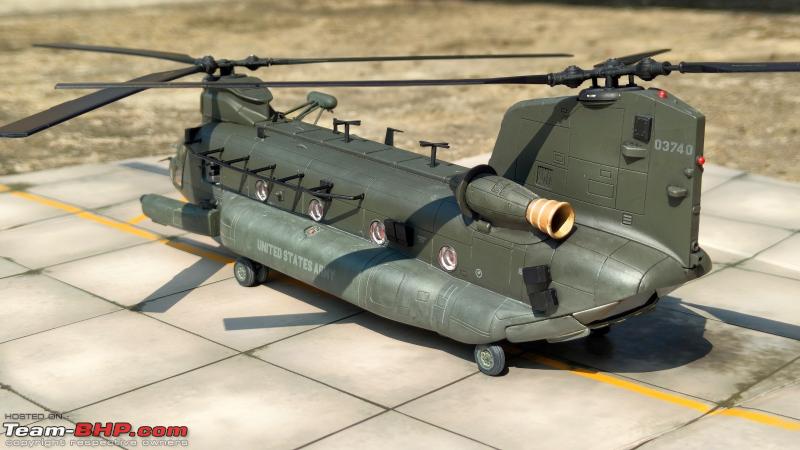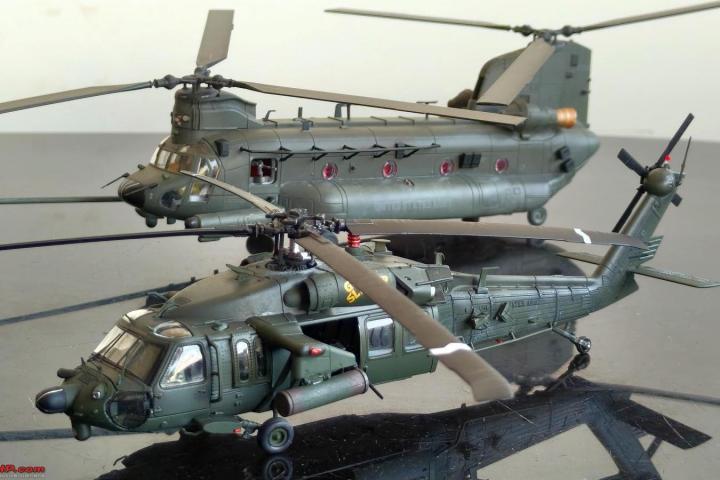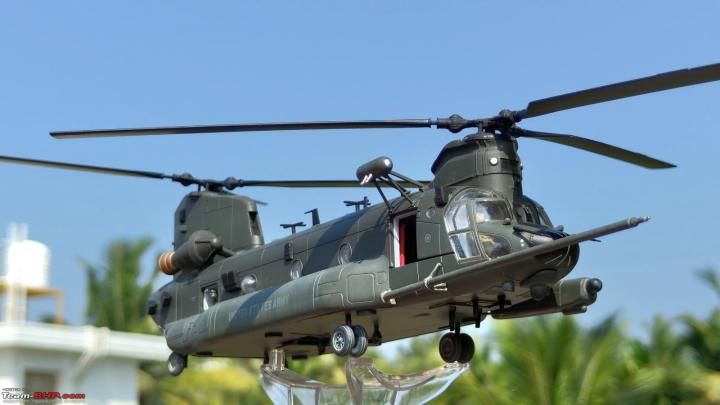News
Scale models of Boeing MH-47G Chinook and MH-60L Blackhawk helicopters
The MH-47G Chinook helicopter can be fitted with internal fuel bladders to act as a static refueling point for other aircraft. This is known as a "Fat Cow" operation.
BHPian skanchan95 recently shared this with other enthusiasts:
1:72 Boeing MH-47G Chinook, 04-3740, 160th SOAR "Night Stalkers", US Army
The Boeing MH-47G Chinook has many of the features of the modern CH-47F, but differs from its sister model with the incorporation of combat systems designed to make the helicopter more survivable on missions deep into enemy territory, at night and while flying at low level. It is primarily used for the insertion, extraction and resupply of Special Forces troops. The first new-build MH-47G helicopter was delivered to the U.S. Army in 2014.
The MH-47 also has in-flight refueling capability for long-range insertions. The helicopter can be used for parachute insertion, fast rope insertion and water insertion of special operations troops. The MH-47G’s fully integrated digital Common Avionics Architecture System (CAAS) permits global communications and navigation. CAAS is among the most advanced U.S. Army helicopter systems. CAAS includes integrated forward-looking infrared (FLIR) and multimode radar for nap-of-the-earth and low-level flight operations in conditions of extremely poor visibility and adverse weather. Today’s MH-47Gs contain a fully integrated digital cockpit management system, long-range fuel tanks and advanced cargo-handling capabilities that complement the aircraft’s mission performance and handling characteristics.
The MH-47G combines many proven Chinook systems and features. Notable among these are fuel tanks providing twice the capacity of the CH-47F and an in-flight refueling system. MH-47Gs are remanufactured on the common MH-47G/CH-47F production line. The Chinook has been in U.S. Army service since 1962, and the current CH-47F/MH- 47G modernization programs, which includes a mix of remanufactured and new aircraft, will ensure this tandem rotor helicopter remains in the Army fleet at least through the 2030s.
The MH-47G Chinook helicopter can be fitted with internal fuel bladders to act as a static refueling point for other aircraft. This is known as a "Fat Cow" operation.
Its wide-loading ramp can be opened in-flight for paratroopers, and three cargo hooks can extend through a floor hatch, which allows the Chinook to be used as a flying crane.
MH-47G Sensors
- AN/ZSQ-2 EOSS - A forward-looking infrared (FLIR) and electro-optical camera mounting in a bubble under the helicopter's chin enables the pilots to fly low level, at night and in marginal weather
- AN/APQ-174B Multi-mode Radar 'Silent Knight' multi-mode radar. The MH-47's radar features terrain-following, terrain-avoidance and weather-detection modes
Chinook's tandem rotor configuration

A tandem-rotor aircraft is an aircraft with two large helicopter rotor assemblies mounted one in front of the other in the horizontal plane. This configuration is mainly used for large cargo helicopters.
Single-rotor helicopters need a mechanism to neutralize the yawing movement produced by the single large rotor. This is commonly accomplished by a tail rotor, coaxial rotors, and the NOTAR systems. Tandem-rotor helicopters, however, use counter-rotating rotors, with each cancelling out the other's torque. Therefore, all of the power from the engines can be used for lift, whereas a single-rotor helicopter uses some of the engine power to counter the torque. Tandem-rotor helicopters typically require less power to hover and achieve low-speed flight as compared to single-rotor helicopters.
160th SOAR "Nightstalkers"
The 160th Special Operations Aviation Regiment (Airborne) "Nightstalkers", abbreviated as 160th SOAR (A), is a special operations force of the United States Army that provides helicopter aviation support for special operations forces. Its missions have included attack, assault, and reconnaissance, and these missions are usually conducted at night, at high speeds, low altitudes, and on short notice.
The 160th SOAR consists of some of the US Army's best-qualified aviators, crew chiefs, and support soldiers. The 160th SOAR has participated in operations all around the world over the years including the Gulf War, Panama invasion, Somalia, Afghanistan etc.
Nicknamed the Night Stalkers and called Task Force Brown within the JSOC, the 160th SOAR(A) is headquartered at Fort Campbell, Kentucky.
The 160th SOAR operates a fleet of MH-47G Chinooks, MH-60L/M Black Hawks and AH/MH-6 Little Birds
Specifications
- Crew: Pilot, Co-pilot + 3 crew chiefs/gunners
- Engines: 2 x Textron Lycoming T55-4-714 Turboshaft engines
- Dimensions
- L - 15.87m
- W (rotor diameter) - 18.82m
- H - 5.59m
- Max Speed: 259 kmph
- Range: 1382 km
Weights
- 12,210 kg (empty)
- 24,494 kg (max loadout)
Armament:
- 4 gun stations (port/starboard front and rear) :
- 2 x M134 7.62mm miniguns (front)
- 2 x M240D 7.62mm machine gun (rear)


MH-47s are armed with M134 7.62mm electrically-operated, air-cooled gatling guns, fitted in firing the left port/right cabin door aft of the cockpit. E/G models also have M240 7.62mm belt-fed machine guns fitted to windows towards the rear.

MH-47G uses 2 T55-GA-714A engines with IES-47 Infrared Exhaust Suppressors fitted to reduce the helicopter's IR visibility.






The multimode radar is visible along the aircraft's forward-left fuselage. This piece of kit includes a terrain-avoidance and terrain-following radar, data from which is displayed on the cockpit's MFDs, allowing the pilots to navigate at low levels over land and water in low visibility conditions. The most current version of this radar is the AN/APQ-187 SilentKnight.






This port can be opened up fully to create a doorway from which troops can fast-rope down to the ground or a M134 minigun can be mounted too. Note the winch fitted over the doorway. This can be used to lift individual troops up into the aircraft. A rope ladder can also be fitted here.








The Cabin detailing




The Nightstalkers
NSDQ - Night Stalkers Don't Quit
Two of the helicopters operated by the 160th SOAR - MH-47G Chinook & MH-60L Blackhawk









Check out BHPian comments for more insights and information.

















.jpg)







